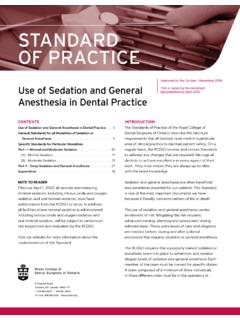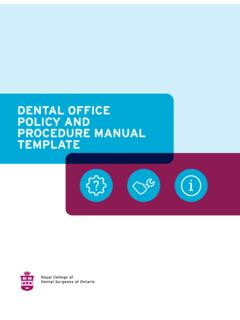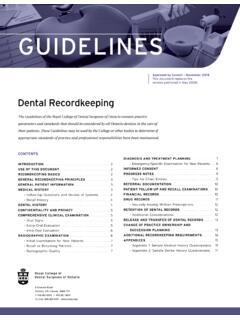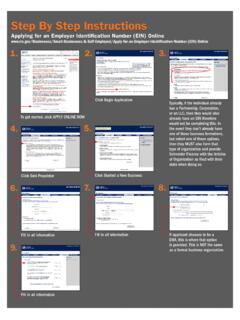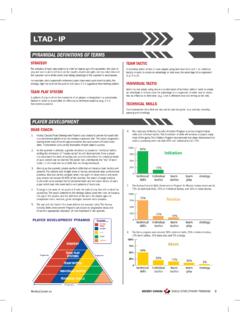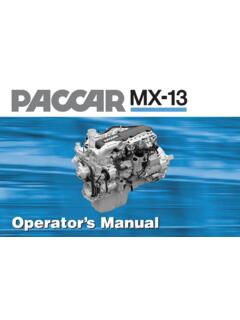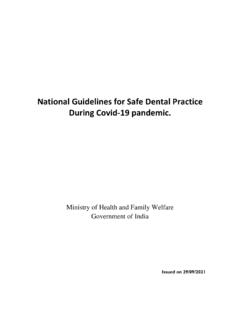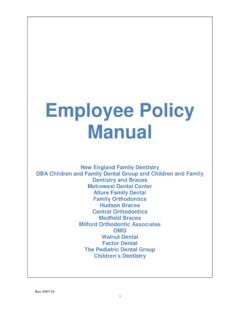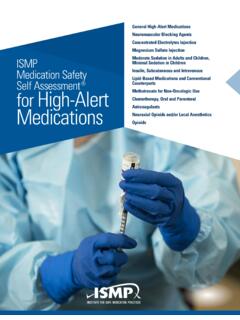Transcription of 1InfectiIo PfrfIctiIovIaodiIcPiCotIoclfohfIcvCoDnntef 1 ...
1 11 InfectiIo PfrfIctiIovIaodiIcPiCotIoclfohfIcvCoDnnt efInfection Prevention and Control in the dental Office6 Crescent RoadToronto, ON Canada M4W 1T1T: F: Toll Free: 3 Purpose of the Document 4 Professional and Regulatory Considerations 4 Principles of Infection Prevention and Control (IPAC) 5 Patient Safety 6 Transmission of Microorganisms 6 Screening of Patients 6 Routine practices 7 Risk assessment 7 Hand Hygiene 7 Protective Barriers and Techniques 11 General considerationsProtective eyewear Protective drapingUse of rubber dam and high-volume suctionLatex sensitivity and allergiesHandling and Disposal of Sharps 11 Additional Precautions 12 Human Rights and Confidentiality 12 STANDARD OF PRACTICEA pproved by the College November 2018 This is replacing the document last published in February Health Care Workers Responsibilities and Safety 13 Education and Training 13 Immunization 13 Illness and Work Restrictions 14 Exposure Prevention 14 Personal Protective
2 Equipment 15 General considerationsGlovesProtective eyewearMasksProtective clothingLatex sensitivity and allergiesMinimizing Droplet Spatter 17 Exposure Management 17 Occupational Health and Safety Requirements and WHMIS 18 Prohibition of Eating and Drinking in Non-Designated Areas 18 Cleaning, Disinfection and Sterilization of Patient-Care Items 19 General Considerations 19 Reprocessing of Instruments 20 Receiving, cleaning and decontaminationRinsing and dryingPreparation and packagingSterilizationMonitoring of sterilizationStorageSterilization of Unpackaged Instruments 25 Reprocessing of Non-Critical Items 26 Reprocessing Equipment Purchase, Use and Preventive Maintenance 26 Standard of Practice | November 20182 Office Cleaning.
3 Housekeeping and Management of Waste 26 General Considerations 26 Clinical Contact Surfaces 27 Housekeeping Surfaces 28 Cleaning up Blood and Body Fluid Spills 28 Management of Waste 28 Biomedical wasteGeneral office wasteHandling of extracted teethEquipment and Area Specific Practice Guidelines 30 dental Unit Waterlines 30 Boil Water Advisories 30 dental Handpieces 31 Saliva Ejectors 31 Single-Use Devices 31 dental Radiography Equipment 32 Digital Radiography Sensors and Intra-Oral Cameras 32 Lasers and Electrosurgery Equipment 32 dental Laboratory Asepsis 33 Safe Handling of Injectables 33 Aseptic techniqueSingle dose vialsMulti-dose vialsHandling of Biopsy Specimens 34 General and Surgical Aseptic Technique 35 Glossary of IPAC Terms 36 AppendicesAppendix 1 Methods for Cleaning, Disinfection and Sterilization of Patient-Care Instruments, Items and Environmental Surfaces 38 Appendix 2 Additional Resources and Reference Materials Available on the Internet 3931 InfectiIo PfrfIctiIovIaodiIcPiCotIoclfohfIcvCoDnnt efIntroductionThe Standards of Practice of the Royal College of dental Surgeons of Ontario (RCDSO) describe the minimum requirements that all dentists must meet in a particular area of clinical practice to maintain patient safety.
4 On a regular basis, the RCDSO reviews and revises Standards to address any changes that are required. We urge all dentists to achieve excellence in every aspect of their work. They must ensure they are always up-to-date with the latest knowledge. Infection prevention and control (IPAC) is a critically important part of safe patient care. In recent years, concerns about the possible spread of blood-borne diseases, and the impact of emerging, highly contagious respiratory and other illnesses have grown. Dentists and other health care workers have a clear responsibility to establish, evaluate, continually update and monitor their IPAC strategies and World Health Organization describes IPAC as:..a practical, evidence-based approach which prevents patients and health workers from being harmed by avoidable infections.
5 Preventing health care-associated infections avoids this unnecessary harm and at times even death, saves money, reduces the spread of antimicrobial resistance (AMR) and supports high quality, integrated, people-centred health services. Ontario s Provincial Infectious Diseases Advisory Committee (PIDAC) agrees that Infection Prevention and Control has never been more important:Health care-associated infections affect 4% to 10% of patients and result in significant harm to patients/residents/clients. Maintaining a safe, clean and hygienic environment and minimizing microbial contamination of surfaces, items and equipment within the health care environment is increasingly recognized as an essential approach to reducing the risk of health care-associated infections for all patients/residents/clients, visitors and staff within health care World Health Organization and the PIDAC are among a growing number of organizations that advocate for antimicrobial stewardship.
6 The RCDSO is only one component of a larger system in Ontario to protect the health and well-being of patients. Public Health Ontario (PHO) provides the scientific evidence and expert guidance that shapes policies and practices for a healthier Ontario. The Ontario Ministry of Health and Long-Term Care (MOHLTC) has separate authority and legislation independent of the RCDSO and sets standards to be applied by local public health units. Those public health units have their own legislative mandate, expertise and role in their communities. They are also required to follow the MOHLTC s Infection Prevention and Control Complaint Protocol and the Infection Prevention and Control Disclosure Protocol .The RCDSO has worked with all of these partners to insure our IPAC Standard aligns with PHO, the Public Health Agency of Canada and the continue to collaborate with PHO and the MOHLTC to ensure that our standards, advice to members and the public are coherent and consistent with their guidelines and checklists for dental practices .
7 This collaboration is reciprocal as we provide information to them about the practice of possible, recommendations are based on data from well-designed scientific studies. However, some infection prevention and control practices routinely used by health care practitioners cannot be rigorously examined for ethical or logistical reasons. In the absence of scientific evidence for such practices , certain recommendations are based on strong theoretical rationale, suggestive evidence or opinions of respected authorities. Contravention of this or any Standard of the RCDSO may be considered professional misconduct. Standard of Practice | November 20184 PURPOSE OF THE DOCUMENTThis document is intended to provide all oral health care workers (OHCWs) with the knowledge to properly implement necessary IPAC measures in dental practice.
8 It consolidates legislation, published standards and recommendations from government and other agencies, regulatory bodies and professional associations, as relevant to a dental context (see Appendix 2).This document presents best practices , reflecting the best evidence and expert opinion available at the time of this document, the following assumptions have been made: The terms oral health care worker (OHCW) and staff are used interchangeably. Staff encompasses all persons conducting activities within or associated with dental offices and includes dentists, dental hygienists, dental assistants, anesthetists and other support persons. The term dental office includes any facility in which oral health care is provided, such as traditional dental practices , community and school-based dental clinics, and collective living centres and other institutional settings.
9 OHCWs are trained to take precautions in order to protect patients and staff. In addition to previous instruction, it is important that all OHCWs receive office-specific training in IPAC as part of their orientation, and whenever new tasks, procedures or equipment are introduced. It is recommended that one staff person should be appointed to manage the dental office s IPAC program and ensure that it remains current. While IPAC is the responsibility of all OHCWs, implementation and oversight rests with the principal dentist(s).PROFESSIONAL AND REGULATORY CONSIDERATIONSD entists have an obligation to maintain the standards of practice of the profession and must ensure that recommended IPAC policies and procedures are carried out in their must maintain current knowledge of IPAC policies and procedures, and apply and maintain them appropriately and consistently.
10 It is the dentist s responsibility to ensure that staff are adequately trained in IPAC policies and procedures, and that the necessary supplies and equipment are available, fully operational, up to date and routinely monitored for also have an ethical duty to maintain a safe and healthy office environment for both patients and staff, and to adhere to all rules and regulations related to the operation of a dental practice, including workplace health and safety, and environmental PfrfIctiIovIaodiIcPiCotIoclfohfIcvCoDnnt efThe risk of infection as a result of a dental procedure is extremely low, but it represents an important patient safety consideration. By understanding how diseases are transmitted, and applying IPAC principles, OHCWs can develop strategies to interrupt the transmission of microorganisms among patients and OHCWs, and from dental instruments, handpieces, devices and principles include: risk assessment ; following routine practices ; using barrier techniques to protect both patients and OHCWs; applying the principles of cleaning, disinfection, sterilization and storage of dental instruments; environmental cleaning; care of the overall office setting; safe handling and disposal of overall IPAC program must focus on strategies to reduce the risk of transmission.
